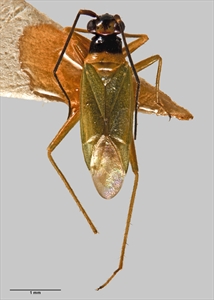- Narrow distribution. Southeast Asia, Oceania. Present in most Pacific island countries. Many introductions. Preys on eggs of Tarophagus species, the taro planthopper.
- Nymphs and adults suck the eggs of Tarophagus. Adult with black antennae, head, pronotum (the area behind the head); wings and legs are orange. Nymphs similar but without wings.
- Eggs are laid into the leaf or into the collapsed eggs of the planthopper. Spread on the wing and in planting material.
- Effective control reported from some countries, but often in dry times there are high populations of both bug and planthopper. Not sufficient for control of viruses diseases.
- Biosecurity: need to assess risk before introduction even though it is probably specific to Tarophagus.
- Avoid use of organophosphates, carbamates and synthetic pyrethroids if Cyrtorhinus present, or leave at least 4 weeks between their use and release of bug.
Pacific Pests, Pathogens and Weeds - Online edition
Pacific Pests, Pathogens, Weeds & Pesticides
Taro egg-sucking bug (399)
Egg-sucking bug
Cyrtorhinus fulvus
AUTHOR Grahame Jackson
Information from Waterhouse DF, Norris KR (1987) Biological Control Pacific Prospects. Inkata Press; and Swaine G (1971) Agricultural Zoology in Fiji. Her Majesty's Stationery Office. London; and from CABI (2018) Cyrtorhinus fulvus. Crop Protection Compendium. (https://www.cabi.org/cpc/datasheet/17538). Photo 2 Woodward TE (1950) Cyrtorhinus cumberi Woordward 1950. Auckland War Memorial Museum. New Zealand. (https://commons.wikimedia.org/wiki/File:Cyrtorhinus_cumberi_Woodward,_1950_(AM_AMNZ21727-1).jpg).
Produced with support from the Australian Centre for International Agricultural Research under project HORT/2016/18: Responding to emerging pest and disease threats to horticulture in the Pacific islands, implemented by the University of Queensland and the Pacific Community.





